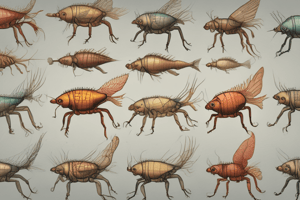Podcast
Questions and Answers
What is the main difference between artificial selection and natural selection?
What is the main difference between artificial selection and natural selection?
- Artificial selection is used for plants, while natural selection is used for animals
- Artificial selection is controlled by humans, while natural selection is not (correct)
- Artificial selection is a slower process than natural selection
- Artificial selection is used for microorganisms, while natural selection is used for macroorganisms
What is the term Darwin used to describe the ability of an individual to survive and reproduce in its specific environment?
What is the term Darwin used to describe the ability of an individual to survive and reproduce in its specific environment?
- Adaptation
- Survival of the fittest
- Struggle for existence
- Fitness (correct)
What is the principle that all living things are derived from common ancestors?
What is the principle that all living things are derived from common ancestors?
- Survival of the fittest
- Artificial Selection
- Common Descent (correct)
- Natural Selection
What is the result of natural selection over time?
What is the result of natural selection over time?
Why was Darwin's 'The Origin of Species' so controversial when it was published?
Why was Darwin's 'The Origin of Species' so controversial when it was published?
What is the term used to describe the variety of living things that inhabit our planet?
What is the term used to describe the variety of living things that inhabit our planet?
According to the scientific definition, what does a theory require?
According to the scientific definition, what does a theory require?
What was one of the reasons why many people in Darwin's day found his ideas unacceptable?
What was one of the reasons why many people in Darwin's day found his ideas unacceptable?
What is the primary focus of evolutionary biologists?
What is the primary focus of evolutionary biologists?
What is the definition of evolution?
What is the definition of evolution?
What prompted Darwin to publish his book, 'On the Origin of Species by Means of Natural Selection'?
What prompted Darwin to publish his book, 'On the Origin of Species by Means of Natural Selection'?
What is the collection of scientific facts, observations, and hypotheses that attempt to explain the diversity of life on Earth?
What is the collection of scientific facts, observations, and hypotheses that attempt to explain the diversity of life on Earth?
What did Darwin observe in the Galapagos Islands that supported his theory of evolution?
What did Darwin observe in the Galapagos Islands that supported his theory of evolution?
What is the process by which organisms become 'adapted' to their environment, according to Darwin?
What is the process by which organisms become 'adapted' to their environment, according to Darwin?
What is the term Darwin used to describe the process by which species change over time?
What is the term Darwin used to describe the process by which species change over time?
What was Charles Darwin's significant contribution to science?
What was Charles Darwin's significant contribution to science?
What did Darwin observe during his travels in a Brazilian forest?
What did Darwin observe during his travels in a Brazilian forest?
What did Darwin's study of fossils lead him to speculate about?
What did Darwin's study of fossils lead him to speculate about?
What was unique about the organisms found on each Galapagos Island?
What was unique about the organisms found on each Galapagos Island?
What did Darwin begin to hypothesize about during his journey home?
What did Darwin begin to hypothesize about during his journey home?
What is the primary objective of evolutionary biologists?
What is the primary objective of evolutionary biologists?
What is a characteristic of a scientific theory?
What is a characteristic of a scientific theory?
What is the significance of the concept of evolution in understanding biological diversity?
What is the significance of the concept of evolution in understanding biological diversity?
What is the role of evidence in the development of a scientific theory?
What is the role of evidence in the development of a scientific theory?
What is a common misconception about the term 'theory' in a scientific context?
What is a common misconception about the term 'theory' in a scientific context?
What observation led Darwin to speculate about why organisms exhibit certain adaptations?
What observation led Darwin to speculate about why organisms exhibit certain adaptations?
What was unique about the land tortoises of the Galapagos Islands?
What was unique about the land tortoises of the Galapagos Islands?
What did Darwin's study of fossils lead him to speculate about?
What did Darwin's study of fossils lead him to speculate about?
What did Darwin's journey home lead him to hypothesize about?
What did Darwin's journey home lead him to hypothesize about?
What was Darwin's main observation about the plants and animals he observed?
What was Darwin's main observation about the plants and animals he observed?
What is the primary driver of the process of natural selection?
What is the primary driver of the process of natural selection?
What is the result of the 'struggle for existence' in a population?
What is the result of the 'struggle for existence' in a population?
What is the term used to describe the ability of an individual to survive and reproduce in its specific environment?
What is the term used to describe the ability of an individual to survive and reproduce in its specific environment?
What is the term used to describe the process by which farmers selectively breed organisms with desired characteristics?
What is the term used to describe the process by which farmers selectively breed organisms with desired characteristics?
What is the underlying principle of Darwin's theory of evolution?
What is the underlying principle of Darwin's theory of evolution?
What was the primary reason why Darwin was reluctant to publish his ideas on evolution?
What was the primary reason why Darwin was reluctant to publish his ideas on evolution?
What was the significance of Alfred Russel Wallace's letter to Darwin in 1858?
What was the significance of Alfred Russel Wallace's letter to Darwin in 1858?
What is implied by Darwin's concept of 'descent with modification'?
What is implied by Darwin's concept of 'descent with modification'?
What was the main difference between the beliefs of Darwin's contemporaries and his own theory of evolution?
What was the main difference between the beliefs of Darwin's contemporaries and his own theory of evolution?
What is suggested by Darwin's observation of the 13 species of finches in the Galapagos Islands?
What is suggested by Darwin's observation of the 13 species of finches in the Galapagos Islands?
Flashcards are hidden until you start studying
Study Notes
Introduction to Evolutionary Theory
- Biological diversity refers to the variety of living things that inhabit our planet, and evolutionary biologists ask questions about how and why organisms live where they do.
- A scientific theory is an explanation based on observation, experimentation, and reasoning, supported by a large quantity of evidence, that does not conflict with existing experimental results.
What is Evolution?
- Evolution means "changes over time" and is the process by which modern organisms have descended from ancient organisms.
- Evolutionary theory is the collection of scientific facts, observations, and hypotheses that attempt to explain the diversity of life on Earth.
Charles Darwin and Evolution
- Charles Darwin contributed more to our understanding of evolution than any other scientist.
- Darwin observed many species on his travels, noting adaptations that enhance survival and reproduction in specific environments.
- He collected fossils, observing similarities and differences among many different organisms, leading him to conclude that organisms had changed over time.
Observations on the Galapagos Islands
- The Galapagos Islands provided a unique opportunity for Darwin to observe species with special adaptations that allowed them to survive on each island.
- Tortoises on different islands had distinct shell shapes, adapted to their specific island environments.
Darwin's Theory of Evolution
- Darwin hypothesized that separate species evolve from ancestral species after becoming isolated from one another.
- He proposed a mechanism for evolution called natural selection, where individuals with certain inherited traits leave more offspring than individuals with other traits.
Descent with Modification
- Darwin used the term "descent with modification" to describe how all organisms descended from a common ancestor and changed over time.
- He observed that finches on the Galapagos Islands had distinct beak shapes adapted to specific food sources.
Artificial Selection
- Darwin noted that plant and animal breeders select for desired characteristics, exemplifying artificial selection.
Evolution by Natural Selection
- Darwin's evolutionary theory is based on concepts including:
- Stability in the process of reproduction
- Chance variations among individual organisms
- The struggle for existence, where members of a species compete for resources
- Fitness, or the ability of an individual to survive and reproduce in its environment
- Adaptations, or inherited characteristics that increase an organism's chance of survival
- Natural selection is the process in which individuals with certain favorable inherited traits leave more offspring than individuals with other traits.
Common Descent
- Darwin's idea of "descent with modification" implies that all living organisms are related to one another, a principle known as common descent.
The Controversy
- Darwin's "The Origin of Species" was radical for its time, challenging the ideas that the Earth was only a few thousand years old and that life forms were unchanging and individually created.
Summary of the Darwinian View of Life
- Key features of the Darwinian view of life include:
- Individuals have different traits and characteristics that are heritable
- Organisms produce more offspring than can survive, leading to competition for limited resources
- Individuals best suited to their environment are more likely to survive and reproduce
- This process of natural selection causes species to change over time
Introduction to Evolutionary Theory
- Biological diversity refers to the variety of living things that inhabit our planet, and evolutionary biologists ask questions about how and why organisms live where they do.
- A scientific theory is an explanation based on observation, experimentation, and reasoning, supported by a large quantity of evidence, that does not conflict with existing experimental results.
What is Evolution?
- Evolution means "changes over time" and is the process by which modern organisms have descended from ancient organisms.
- Evolutionary theory is the collection of scientific facts, observations, and hypotheses that attempt to explain the diversity of life on Earth.
Charles Darwin and Evolution
- Charles Darwin contributed more to our understanding of evolution than any other scientist.
- Darwin observed many species on his travels, noting adaptations that enhance survival and reproduction in specific environments.
- He collected fossils, observing similarities and differences among many different organisms, leading him to conclude that organisms had changed over time.
Observations on the Galapagos Islands
- The Galapagos Islands provided a unique opportunity for Darwin to observe species with special adaptations that allowed them to survive on each island.
- Tortoises on different islands had distinct shell shapes, adapted to their specific island environments.
Darwin's Theory of Evolution
- Darwin hypothesized that separate species evolve from ancestral species after becoming isolated from one another.
- He proposed a mechanism for evolution called natural selection, where individuals with certain inherited traits leave more offspring than individuals with other traits.
Descent with Modification
- Darwin used the term "descent with modification" to describe how all organisms descended from a common ancestor and changed over time.
- He observed that finches on the Galapagos Islands had distinct beak shapes adapted to specific food sources.
Artificial Selection
- Darwin noted that plant and animal breeders select for desired characteristics, exemplifying artificial selection.
Evolution by Natural Selection
- Darwin's evolutionary theory is based on concepts including:
- Stability in the process of reproduction
- Chance variations among individual organisms
- The struggle for existence, where members of a species compete for resources
- Fitness, or the ability of an individual to survive and reproduce in its environment
- Adaptations, or inherited characteristics that increase an organism's chance of survival
- Natural selection is the process in which individuals with certain favorable inherited traits leave more offspring than individuals with other traits.
Common Descent
- Darwin's idea of "descent with modification" implies that all living organisms are related to one another, a principle known as common descent.
The Controversy
- Darwin's "The Origin of Species" was radical for its time, challenging the ideas that the Earth was only a few thousand years old and that life forms were unchanging and individually created.
Summary of the Darwinian View of Life
- Key features of the Darwinian view of life include:
- Individuals have different traits and characteristics that are heritable
- Organisms produce more offspring than can survive, leading to competition for limited resources
- Individuals best suited to their environment are more likely to survive and reproduce
- This process of natural selection causes species to change over time
Studying That Suits You
Use AI to generate personalized quizzes and flashcards to suit your learning preferences.




